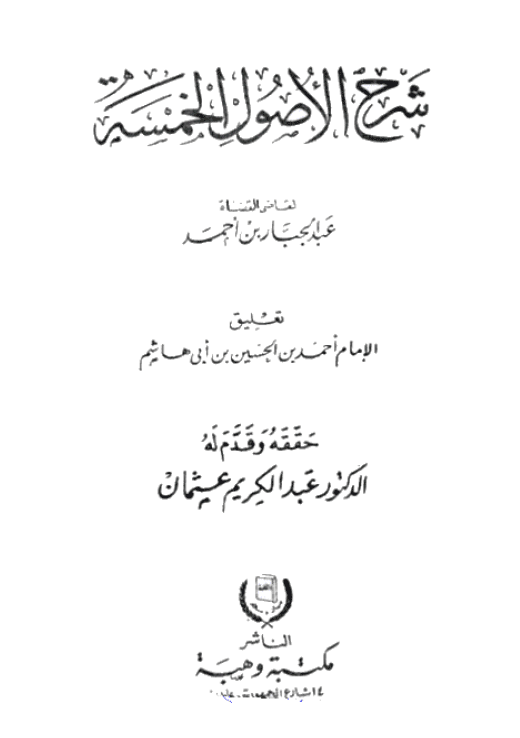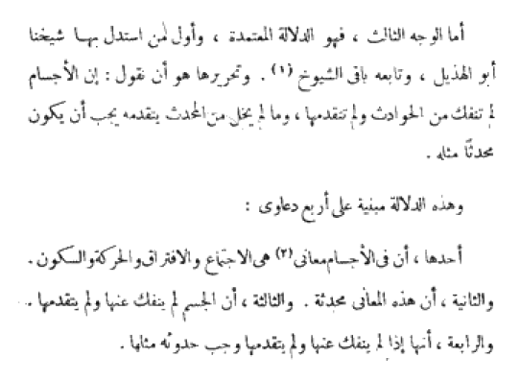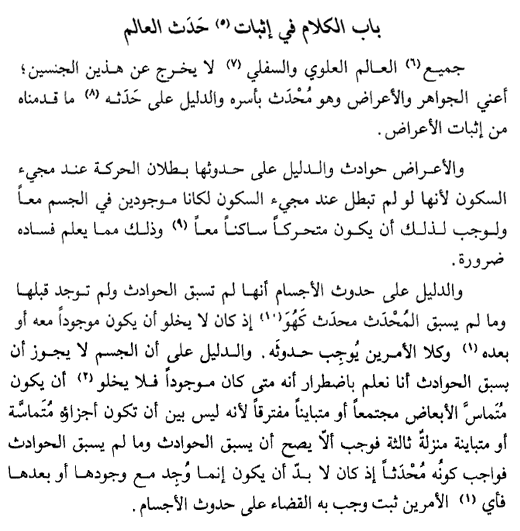| Friday, 26 April 2024 |
|
|
|
|
Never see Ash'ariyyah in the same light, ever again! Aristotle of Stageira, Philo of Alexandria, Augustine of Hippo, the Sabeans of Harraan, the Mu'tazilites of Basrah and Baghdad and the Jahmite Ash'ari Heretics of Today Claiming Orthodoxy. Read the first article, the second article, the third article, the fourth article, the fifth article.
| |
You are here:
Home  Articles
Articles
All praise is due to Allaah the Lord of the Worlds and may the prayers and salutations be upon His Messenger, to proceed.
Introduction In many previous articles we have explained that Jahm bin Safwan concocted an intellectual, rational proof to demonstrate the existence of a Creator to some Indian Materialist Atheist Philosophers called the Sumaniyyah who had confused him initially. His intellectual proof was based around bodies (ajsaam) being created because of the qualities (sifaat) and incidental attributes (a'raad) and occurrences (hawaadith) in them, and he was the first to utilize this proof, albeit in a cruder form than did the Mu'tazilah who simply refined it, cleaned it up and tried to fill the holes in it through incorporating the notion of al-Jawhar al-Fard (the indivisible particle) into it, and the Ash'ariyyah simply "borrowed" it from the Mu'tazilah. It was on account of the intellectual proof that Jahm bin Safwan devised that he was forced to speak with the following, amongst many other things:
And the Mu'tazilah took from the Jahmiyyah much of their sayings and the Mu'tazilah too were involved in debates with the Indian Materialist Philosphers. There occurs in the book "Buhooth Fil-Milal wan-Nihal" (3/437), that debates with these Indian Philosophers, the Sumaniyyah, was something that the Mu'tazilah were upon also, the author speaking about the Mu'tazilah, says:
Abu al-Hudhayl al-Allaaf (d. 235H), who was one of the heads of the Mu'tazilah, refined this proof and formalized it, and then all of the other Mu'tazilah took it from al-Allaaf, and it became integral to the madhhab. As al-Ash'ari was a Mu'tazili for most of his life, he was upon this, and the Ash'aris introduced some new concepts into it such as "al-'arad laa yabqaa zamaanayn" (an incidental attribute does not last for two instances of time) - in order to make up for the deficiencies in this proof, and in order to allow them to justify, from a rational point of view, the affirmation of (some of) the attributes, in opposition to the Mu'tazilah, who accepted none. And this proof can be seen in the work of al-Baqillani (d. 403H), "at-Tamheed", who is said to be the codifier of the early Ash'ari madhhab, as well as in all major Ash'arite textbooks. Objective of This Article Our aim in this article is to simply document from primary Mu'tazili sources that Abu al-Hudhayl al-Allaaf (d. 235H), a head of the Mu'tazilah, was the very first one to use a formalized refined version of Jahm's crude version of the proof of the createdness of the universe against the Indian Materialist Philosophers. From this we will then see that the deen of the Ash'arites is based around this same intellectual proof, with some minor differences in its subsidiary details, and as such, the only true and real difference between the Ash'ariyyah and Mu'tazilah is on the subject of what can and cannot be denied for Allaah in order to make sure that the intellectual proof is not invalidated. Thus the Mu'tazilah denied that Allaah is described with Attributes, because to them, this invalidates the intellectual proof of "hudooth ul-ajsaam", and the Ash'aris found a way to affirm, rationally (not textually), some of the attributes, and they modified their intellectual proof to accommodate this. In reality, they simply adopted the deen of Ibn Kullaab and tried to concoct a rational explanation and justification of why affirming some attributes does not invalidate the intellectual proof, so they could find some means to argue against the Mu'tazilah. Thus their speech that time (zamaan) too is broken down into indivisible units, and that "al-'arad laa yabqaa zamaanayn" (an incidental attribute) does not last two instances of time) - inshaa'Allaah we can make this the subject of another article, because it allows us to see how and why the Ash'aris affirmed some attributes as opposed to others, how they justified it, and how they avoided invalidating the intellectual proof, by adding some other principles to what they inherited from the Mu'tazilah.
But as for the base and foundation, they all took it from Jahm bin Safwaan, through succession, and they are all agreed upon it. And this is the Ilm ul-Kalaam that the Salaf condemned, and this is the Ilm ul-Kalaam that gave rise to the sayings that the Qur'aan is created and that Allaah will not be seen in the Hereafter and there is no deity above the Throne and so on. Al-Qadi Abdul-Jabbar al-Mu'tazili on the Abu al-Hudhayl al-Allaaf and The Proof of hudooth ul-ajsaam Here is the cover to al-Qadi Abdul-Jabbar's "Sharh Usool ul-Khamsah":
And here is page 96, and he is speaking about the ways of establishing the createdness of the universe to prove Allaah's existence, having mentioned two already connected to ajsaam (bodies) and a'raad (their incidental attributes), he then says:
Which translates as:
And then he summarizes it, saying, (and whatever is in square brackets are explanatory additions by us):
Al-Qadi Abu Bakr al-Baqillani on the Proof of hudooth ul-ajsaam All the major textbooks of the Ash'aris contain the proof of "hudooth ul-ajsaam" upon the manner of the Mu'tazilah. This is a list of their major textbooks:
Here we just want to give an example from al-Baqillani (d. 403) who was the first of those who ascribe to al-Ash'ari to put it down and codify it in his books. You should remember that the Jahm bin Safwan and the Jahmiyyah and Abu al-Hudhayl al-Allaaf and the Mu'tazilah were the pioneers of this proof - and the Ash'aris simply "borrowed" it and refined it a little more. The Ash'ari creed is in fact just a mixture of the usool of the Mu'tazilah coupled with the attempts of Ibn Kullaab (d. 240) to reconcile those usool with the creed of Ahl us-Sunnah - be not in doubt about that, for it is the sure truth, and this has been and will be further demonstrated on this site in other articles. Al-Baqillani writes in his "at-Tamheed", (pp. 41-43):
The translation of which is:
Al-Baqillani is simply following on with what was pioneered by the Jahmiyyah and the Mu'tazilah (as did all the Ash'aris - although Abu al-Hasan al-Ash'ari himself, after abandoning the Mu'tazilah, declared this method to be an innovation) - and it was on account of this proof that they were forced to negate, to varying degrees, what Allaah described Himself with. Explanation of the Above The Jahmites and Mu'tazilah, who preceded the Ash'arite Theologians by up to two centuries - were much involved in debates with the Philosophers and atheists that were found in the lands to which Islam spread. And as these groups did not affirm revelation, then these Theologians (those who indulged in this Kalaam from the Jahmiyyah and Mu'tazilah) sought a proof by which they could argue for
And doing this without having to refer back to the revealed texts at all. meaning it had to be a purely intellectual proof, from beginning to end. As these things are the most basic foundations in leading a person to belief in a creator and what follows on from that, they sought a rational proof that would allow them to achieve this, and they thought that this has to be the most important fundamental basis of the religion itself,and this is what they call Usool ud-Deen, its their kalaamist theology based around these subjects. Jahm bin Safwan used a crude form of "hudooth ul-ajsaam", demonstrating that because bodies have qualities (sifaat) and incidental attributes (a'raad), this is a proof that they are newly-arisen, created. And there were many atheist Philosophers in the Muslim lands who were conversant with and who were upon the Philosophy of the Greeks and of Aristotle in particular and his classification of the universe into jawhar (substance) and nine categories of incidental attribute ('arad), and together these were known as "al-maqaalaat al-ashar" (the ten sayings) to the Mutafalsifah and Mutakallimoon who adopted this. So the likes of Jahm (and the Mu'tazilah) utilized these notions to devise a proof against those atheist Philosophers. And the Mu'tazilah took up this proof first used by Jahm, but they saw flaws in it and they introduced other elements into it, so they took the theory of "the indivisible particle" (al-jawhar al-fard, al-juz alladhee laa yatajazza') of Democritus (d. 370BC), another Greek Philosopher, and so they said that all bodies (ajsaam) are made up of indivisible particles and that their incidental attributes (a'raad) are present at the level of of this indivisible particle. And the Ash'aris took this from the Mu'tazilah but differed with them on subsidiary issues and they invented other concepts which they used to incorporate into this intellectual proof, on account of which they argued against the Mu'tazilah. But with respect to the underlying root and foundation, they are all agreed upon its concepts - and this the spring and fountain of their ta'teel - and which led them to ta'weel and tafweed. So now we have the basics laid down, let us see through this rational explanation, and it works something like this. Let's take pebble and a pebble is what is defined as substance (jawhar), however, it is said to be a jism (body), since a body (according to some of the Theologians - they differ amongst themselves) is whatever is made up of at least two indivisible particles - so we have a pebble that is made up of substance (jawhar) and we refer to it is a body (jism). Now this pebble has width, height, depth, texture, color, hardness and so on. These are incidental attributes of this pebble. And anything that is a jism (body) is surrounded by space, it exists in space and location, and in relation to other things it has direction (jihah). So according to their reasoning, all bodies (whatever we see around us in the universe) have undergone temporal incidental attributes. These are what are called (a'raad) also called more formally as "accidents". And similarly bodies also have occurrences, or events (hawaadith) taking place in them, so say for example someone speaking, that's an event, an occurrence, something that happened after it did not. Or a leaf being at rest, then going through motion on so that's motion, an event, an occurrence. And these "accidents" also occur at the level of the smallest indivisible particle (al-Jawhar al-Fard), and indivisible particles are subject to combination, separation, motion and rest, which are also a'raad (incidental attributes) and hawaadith (events). So you get the picture, all bodies have incidental attributes (like the height, skin color of a human) and those attributes which are temporal such as having a headache, or feeling sad for example - these are all called "a'raad" - those things which are temporary or non-essential. And there are other which are events, occurrences, things that take place after not having taken place in that body. So a'raad (incidental attributes) and hawaadith (occurrences) are proof - to the Mutakallimoon - that bodies are created, and this is their basis for demonstrating the createdness of the universe. Now, not all bodies have the same a'raad (incidental attributes), that's why Aristotle mentioned all the different categories of a'raad that bodies have. And to give some examples: color, shape, taste, smell, heat, cold, wetness, dryness, texture, number, space, location, direction, width, height, depth, motion, rest and so on. So - according to the refined version of the intellectual proof - all bodies have collectively a wide range of a'raad (incidental attributes), but at the level of the indivisible particle (al-Jawhar al-Fard) - which the entire universe is made up of - according to them - they needed to make the argument by way of a'raad that are common to every body (jism), to every thing basically. And so there are two sets of a'raad that they decided to use in developing the rational foundation for "hudooth ul-ajsaam":
This means indivisible particles coming together after being separated, or separating after being combined, or being at motion after rest, or rest after motion. What this means is that, at the most basic level, we can use either of these two pairs of a'raad in our argument. We don't need to worry about color, wetness, dryness, depth and so on, because that is not true of all bodies, or particles. But what is common to them all is either of these two pairs of a'raad (incidental attributes). So this is what al-Qadi Abdul-Jabbar, the Mu'tazili and al-Qadi Abu Bakr al-Baqillani, an early Ash'ari are talking about in what we have quoted from them above. They are talking about the finer detail in the proof of "hudooth ul-ajsaam" that they are all united upon and which led them to reject, to different degrees, Allaah's Attributes. And the originator of this proof, or the first to use it was Jahm bin Safwan against the Indian Materialist Philosophers. Summary and Conclusion The Ash'ariyyah are upon the Usool of the Mu'tazilah as it relates to the proof of "hudooth ul-ajsaam", they simply inherited this from the Mu'tazilah (and the Jahmiyyah before them), and they made some minor modifications to it and improvised it a little with some new principles, to fill in the gaps and holes. The proof of "hudooth ul-ajsaam" is what unites all of the Mutakallimoon (Jahmiyyah, Mu'tazilah, Kullaabiyyah, Ash'ariyyah and Maturidiyyah), and a large part of their creed is tied to it and determined by it. The proof of "hudooth ul-ajsaam" is a corrupt and false proof that actually proves the opposite of what it is set out to prove, and the Philosophers were wise to this, and so when they saw the Mutakallimoon use this proof, the door was opened up for them to attack the deen with strength and vigour.
Link to this article: Show: HTML Link • Full Link • Short Link
Related Articles:
You must be registered and logged in to comment. |


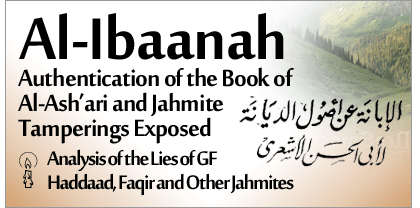



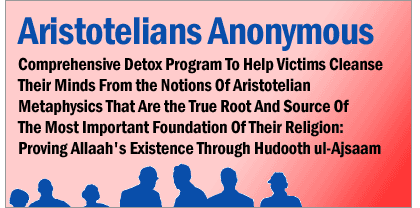
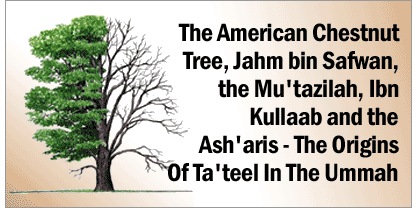
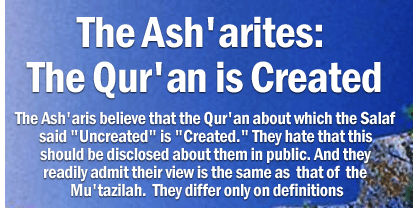
|
||||||||||||||||||||||||||||||||||||||||
 |
 | |
|
|
 ...And then the period of ar-Rasheed came (170H-193H) and history narrates about their vigour during his time, to such an extent that there were none who argued with the
...And then the period of ar-Rasheed came (170H-193H) and history narrates about their vigour during his time, to such an extent that there were none who argued with the 